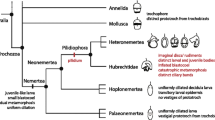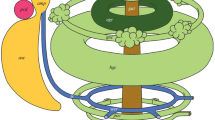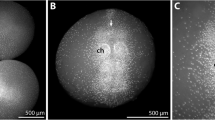Abstract
The prejuvenile development of Echinocardium cordatum (Echinoidea) was investigated by means of scanning electron, confocal and light microscopes, aiming to illustrate the early life history of a spatangoid representative and to compare it with the other major echinoid groups. During the larval development of E. cordatum, two periods follow one another. The first one takes 12 days; it ends with the formation of a complete echinopluteus with twelve elongated larval arms. The second lasts from 3 to 12 days; it is entirely devoted to the building of the echinid rudiment and ends with the acquisition of larval competence. No appendage other than arms develops at the larva’s outer surface. Competent larvae are demersal. They settle onto the substratum and test it for suitability using the five rudiment podia that protrude through the vestibule opening. Metamorphosis is a rapid event that lasts less than an hour. The rudiment does not everse and its spines and podia actively tear up the larval epidermis which is progressively covered by the growing vestibular epidermis. The resulting postlarva is short-lived and morphologically similar to both the late rudiment and the early juvenile, which, however, is exotrophic. Late rudiments in E. cordatum show basic spatangoid features being bilaterally symmetric and having clavulae and sphaeridia. More importantly, they already have the convex shape and the appendage cover of early juveniles. Metamorphosis in E. cordatum appears to be less complex, i.e. no rudiment is everted, and more complete, since, in contrast to “regular” echinoids, no transitory appendages are seen. Metamorphosis/development of E. cordatum, thus, is closer to that of clypeasteroids, since the rudiment of the latter already bears juvenile definitive appendages, when everted during metamorphsis.










Similar content being viewed by others
References
Bosch I, Beauchamp KA, Steele ME, Pearse JS (1987) Development, metamorphosis, and seasonal abundance of embryos and larvae of the Antarctic sea urchin Sterechinus neumayeri. Biol Bull 173:126–135
Burke RD (1980) Podial sensory receptors and the induction of metamorphosis in echinoids. J Exp Mar Biol Ecol 47:223–234
Burke RD (1989) Echinoderm metamorphosis: comparative aspects of the change in form. In: Jangoux M, Lawrence JM (eds) Echinoderm studies, vol 3. Balkema, Rotterdam, pp 81–108
Caldwell JW (1972) Development, metamorphosis and substrate selection of the larvae of the sand dollar, Mellita quinquesperforata (Leske, 1778). Thesis for the degree of Master of Science, University of Florida, 64 pp
Cameron RA, Hinegardner RT (1974) Initiation of metamorphosis in laboratory cultured sea urchins. Biol Bull Mar Biol Lab Woods Hole 146:335–342
Cameron RA, Hinegardner RT (1978) Early events of metamorphosis in sea urchins: Metamorphosis, description and analysis. J Morph 157:21–32
Chia FS (1978) Perspectives: settlement and metamorphosis of marine invertebrate larvae. In: Chia FS, Rice ME (eds) Settlement and metamorphosis of marine invertebrate larvae. Elsevier, New York, pp 283–285
Chia FS, Burke RD (1978) Echinoderm metamorphosis: fate of larval structures. In: Chia FS, Rice ME (eds) Settlement and metamorphosis of marine invertebrate larvae. Elsevier, New York, pp 219–234
Emlet RB (1988) Larval form and metamorphosis of a « primitive » sea urchin, Eucidaris thouarsii (Echinodermata : Echinoidea : Cidaroida), with implications for developmental and phylogenetical studies. Biol Bull 174:4–19
Emlet RB (2000) What is a juvenile sea urchin? A comparative and phylogenetic survey of post-metamorphic juveniles. Zygote 8(suppl):44–45
Emlet RB, McEdward LR, Strathmann RR (1987) Echinoderm larval ecology viewed from the egg. In: Jangoux M, Lawrence JM (eds) Echinoderm Studies 2. Balkema, Rotterdam, pp 55–136
Emlet RB, Young CM, Georges SN (2002) Phylum Echinodermata: Echinoidea. In: Young CM (ed) Atlas of Marine Invertebrate Larvae. Academic, New York, pp 531–551
Fischer AG (1966) Spatangoids. In: Moore RC (ed) Treatise on invertebrate paleontology. Part U. Echinodermata 3:2. Geological Society of America, Boulder, Colorado, University of Kansas Press, Lawrence, pp U543–U628
Flammang P, De Ridder C, Jangoux M (1998) Ultrastructure of the penicillate podia of the spatangoid echinoid Echinocardium cordatum (Echinodermata) with special emphasis on the epidermal sensory–secretory complexes. Acta Zool Stockholm 72(3):151–158
Fuentes I, Barros C (2000) Larval development and metamorphosis of cultured Tetrapygus niger (Echinodermata, Echinoidea): an uncommon form of echinoplutei. Invertebr Reprod Dev 37(3):201–209
Gordon I (1926a) The development of the calcareous test of Echinocardium cordatum. Philos Trans Roy Soc Lond (B) 215:255–313
Gordon I (1926b) On the development of the calcareous test of Echinus miliaris. Philos Trans Roy Soc Lond (B) 214:259–312
Gordon I (1929) Skeletal development in Arbacia, Echinarachnius and Leptasterias. Philos Trans Roy Soc Lond (B) 217:289–334
Gosselin P, Jangoux M (1996) Induction of metamorphosis in Paracentrotus lividus larvae (Echinodermata, Echinoidea). Oceanol Acta 3–4:293–296
Gosselin P, Jangoux M (1998) From competent larva to exotrophic juvenile: a morphofunctional study of the perimetamorphic period of Paracentrotus lividus (Echinodermata, Echinoidea). Zoomorph 118:31–43
Grosjean P, Spirlet C, Gosselin P, Vaïtilingon D, Jangoux M (1998) Land-based, closed-cycle echiniculture of Paracentrotus lividus (Lamarck) (Echinoidea: Echinodermata): a long-term experiment at a pilot scale. J Shellfish Res 17(5):1523–1531
Hanot P, De Ridder C, Jangoux M (1990) Morphologie fonctionnelle des clavules chez le spatangide Echinocardium cordatum (Echinoidea, Echinodermata). In: De Ridder C, Dubois Ph, Lahaye MC, Jangoux M (eds) Echinoderm research, Balkema, Rotterdam, pp 247–254
Highsmith R (1982) Induced settlement and metamorphosis of sand dollar (Dendraster excentricus) larvae in predator-free sites: adult sand dollar beds. Ecology 63:329–337
Highsmith RC, Emlet RB (1986) Delayed metamorphosis – Effect on growth and survival of juvenile sand dollars (Echinoidea, Clypeasteroida). Bull Mar Sci 39(2):347–361
Hinegardner RT (1969) Growth and development of the laboratory cultured sea urchin. Biol Bull 137:465–475
Hyman LB (1955) The invertebrates: Echinodermata, vol IV. McGraw-Hill Book Company, New York, pp 763
Kashenko SD (1994) Development of larvae of the sea urchin Echinocardium cordatum fed various microalgae. Russ J Mar Biol 20(5):289–292
Kryuchkova GA (1979) Development of the definitive skeleton of the sea-urchin Echinocardium cordatum (in Russian). Biol Morya Vladivostok 6:35–43
MacBride E (1903) The development of Echinus esculentus, together with some points in the development of E. miliaris and E. acutus. Philos Trans Roy Soc Lond (B) 195:285–327
MacBride E (1914) The development of Echinocardium cordatum. Part I. The external features of development. Quart J Micr Sci 59(4):471–486
MacBride E (1918) The development of Echinocardium cordatum. Part II. The development of the internal organs. Quart J Micr Soc London 63:259–282
Markov AV, Kushlina VB (1990) Postlarval development of some spatangoid sea urchins. Paleontol J 2:60–68
McEdward LR (1986) Comparative morphometrics of echinoderm larvae. II. Larval size, shape, growth, and the scaling of feeding and metabolism in echinoplutei. J Exp Mar Biol Ecol 96:267–286
McEdward LR, Janies DA (1993) Life cycle evolution in asteroids: what is a larva? Biol Bull 184:255–268
McEdward LR, Miner BG (2001) Larval and life-cycle patterns in echinoderms. Can J Zool 79:1125–1170
Miller BA, Emlet RB (1999) Development of newly metamorphosed juvenile sea urchins (Strongylocentrotus franciscanus and S. purpuratus): morphology, the effects of temperature and larval food ration, and a method for determining age. J Exp Mar Biol Ecol 235:67–90
Mortensen T (1931) Contributions to the study of the development and larval forms of echinoderms. I-II. Mém Acad Roy Sci Lettres Danemark, Copenhague, Sect Sci, 9e série, t IV, n° 1: 1–39
Mortensen T (1937) Contributions to the study of the development and larval forms of echinoderms. III. Mém Acad Roy Sci Lettres Danemark, Copenhague, Sect Sci, 9e série, t VII, n° 1: 1–65
Nichols D (1959) Changes in the chalk heart-urchin Micraster interpreted in relation to living forms. Phil Trans Roy Soc London, Series B 693(242):347–437
Nunes CDAP, Jangoux M (2004) Reproductive cycle of the spatangoid echinoid Echinocardium cordatum (Echinodermata) in the southwestern North Sea. Invertebr Repr Dev 45(1):41–57
Pearse JS, Cameron RA (1991) Echinodermata: Echinoidea. In: Giese AC, Pearse JS, Pearse VB (eds) Reproduction of marine invertebrates, vol VI. Boxwood Press, California, pp 513–662
Rees CB (1953) The larvae of the Spatangidae. J Mar Biol Ass UK 32:477–490
Smith AB (1980) Stereom microstructure of the echinoid test. Spec Pap Palaeontol 25:1–85
Smith AB (1997) Echinoderm larvae and phylogeny. Annu Rev Ecol Syst 28:219–241
Stewart B (1995) Use of the fluorescent marker calcein for biomineralisation studies of the snake star Astrobrachion constrictum (Echinodermata: Ophiuroidea). In: Emson, Smith, Campbell (eds) Echinoderm research 1995. Balkema, Rotterdam, pp 277–282
Strathmann RR (1971) The feeding behavior of planktotrophic echinoderm larvae: Mechanisms, regulation and rates of suspension feeding. J Exp Mar Biol Ecol 6:109–160
Strathmann RR (1975) Larval feeding in echinoderms. Am Zool 15:717–730
Strathmann RR (1978) Larval settlement in echinoderms. In: Chia FS, Rice ME (eds) Settlement and metamorphosis of marine invertebrate larvae. Elsevier, New York, pp 235–246
Sumida PYG, Tyler PA, Thurston MH, Gage JD (2001) Early post-metamorphic ontogenesis of deep-sea spatangoids (Echinoidea, Spatangoida) of the NE Atlantic Ocean. Invert Biol 120(4):378–385
Théel H (1892) On the development of Echinocyamus pusillus. Nova Acta Roy Soc Sci Upsala 15(3):1–57
Thorson G (1950) Reproductive and larval ecology of marine bottom invertebrates. Biol Rev 25(1):1–45
Wray GA (1992) The evolution of larval morphology during the post-Paleozoic radiation of echinoids. Paleobiology 18(3):258–287
Zar JH (1999) Biostatistical Analysis, 4th edn. Prentice-Hall, New Jersey, p 929
Acknowledgments
This research has been supported by an FNRS research grant attributed to C. De Amaral P. Nunes. The authors wish to thank Dr. P. Gosselin for his constant support; E. Bricourt, G. Seghers, J.M. Ouin and P. Postiau for technical assistance; Prof. J. Avoine and D. Bucaille for access to the echiniculture facilities (CREC, Luc-sur-Mer, France); P. Selvakumaraswamy for advices on the procedure of the skeleton calcein-staining; Prof. H. Alexandre, Dr. A. Vancauwenberge and M. Delsinne for assistance with the scanning confocal microscope facilities. This paper is a contribution of the “Centre Universitaire de Biologie Marine” (CIBIM).
Author information
Authors and Affiliations
Corresponding author
Rights and permissions
About this article
Cite this article
De Amaral P. Nunes, C., Jangoux, M. Larval growth and perimetamorphosis in the echinoid Echinocardium cordatum (Echinodermata): the spatangoid way to become a sea urchin. Zoomorphology 126, 103–119 (2007). https://doi.org/10.1007/s00435-007-0032-6
Received:
Accepted:
Published:
Issue Date:
DOI: https://doi.org/10.1007/s00435-007-0032-6




